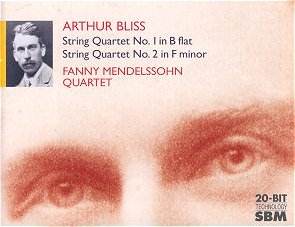 Composer: Arthur Bliss
Composer: Arthur Bliss
Works: String Quartet No. 1 (1941), String Quartet No. 2 (1950)
Performers: Renate Eggebrecht-Kupsa (1st violin), Friedeman Kupsa (cello), Mario Korunic (2nd violin), Stefan Berg (viola)
Recording: Recorded 23-24 July 1995, 4-5 Feb 1996, Bauer Studio, Ludwigsburg
Label: Troubadisc TRO-CD 01412
Arthur Bliss, a luminary of the British musical landscape, composed his two string quartets during pivotal moments in the early to mid-20th century, reflecting the tumultuous historical context of their creation. The First Quartet, completed in 1941 while Bliss was in the United States, resonates with the urgency of a world on the brink of war. Its premiere by the Pro Arte Quartet captures the spirit of an era fraught with tension, while the Second Quartet, introduced at the inaugural Edinburgh Festival in 1950, reveals a composer striving for emotional profundity and formal perfection. Both works encapsulate Bliss’s distinctive harmonic language and rich textural palette, characterized by a visceral engagement with the string medium.
The performance by the ensemble featuring Renate Eggebrecht-Kupsa and her colleagues is commendable, delivering a reading that balances technical precision with an emotional depth that Bliss’s music demands. The First Quartet, with its four movements, unfolds with a palpable sense of yearning and vitality. The players navigate the intricate rhythms and melodic contours with an athleticism that mirrors Bliss’s own robust style. Particularly striking is the interplay between the first and second violins, where Eggebrecht-Kupsa and Korunic engage in a lively dialogue that evokes the spirited yet introspective nature of the music. The recording captures the dynamic contrasts effectively, illuminating Bliss’s unique ability to blend lyrical passages with more vigorous, almost dance-like sections.
In contrast, the Second Quartet emerges as a more complex work, reflecting Bliss’s ambition to encapsulate a deeply felt emotion within a structured form. The first movement’s relentless energy can be overwhelming, yet under the Mendelssohns’ hands, it finds a compelling urgency that propels the listener through its intricate passages. The sostenuto section, described as “hushed breathlessness,” achieves a transcendent quality, evoking the composer’s aspirations. This particular movement serves as an excellent entry point for those unfamiliar with Bliss’s oeuvre, capturing the essence of his musical philosophy. The engineering of this recording benefits from a close microphone placement, providing an intimate listening experience that highlights the players’ nuances and the rich textures of the quartet.
Comparatively, this recording stands up well against the previous Hyperion release featuring the Delmé Quartet. While both recordings offer valuable interpretations, the Troubadisc version’s brisk tempos, especially in the Fourth Movement of the Second Quartet, contribute to a heightened sense of urgency that some might find preferable to the more measured approach of the Hyperion ensemble. Moreover, the clarity of sound in this recording accentuates the harmonic richness of Bliss’s writing, rendering a vibrant listening experience that may sway purists and casual listeners alike.
This recording of Bliss’s string quartets not only illuminates the composer’s unique voice within the chamber music repertoire but also showcases the performers’ adeptness in bringing his intricate textures to life. The combination of historical significance and musical depth in both quartets makes this disc a noteworthy addition to any collection of 20th-century chamber music. The ensemble’s interpretative choices and the engineering quality contribute to a compelling portrait of Bliss’s artistic vision, inviting audiences to appreciate the complexities and emotional layers inherent in his work.

